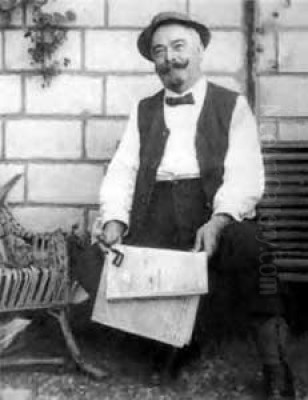
Eugène Galien-Laloue stands as a significant figure in French art history, celebrated primarily for his evocative and detailed depictions of Parisian street scenes during the vibrant era known as the Belle Époque. Born in Paris on December 11, 1854, and living until 1941, Galien-Laloue's life spanned a period of immense social, technological, and artistic change in France. Though sometimes associated with the Impressionist movement due to his focus on light and atmosphere, his meticulous technique and dedication to architectural accuracy set him apart, carving a unique niche for him as a chronicler of the city he called home. His works serve not only as beautiful artistic expressions but also as invaluable historical documents capturing the essence of Paris at the turn of the 20th century.
Early Life and Artistic Formation
Eugène Galien-Laloue's artistic journey began in the heart of Paris. His father, Charles Laloue, was a theatre set designer, an occupation that undoubtedly exposed the young Eugène to the world of art and visual representation from an early age. This familial connection to the arts likely provided a foundational inspiration for his future path. Initially, however, Galien-Laloue pursued training in architecture. This early education in architectural principles would prove influential throughout his career, manifesting in the remarkable precision and detail found in his renderings of Paris's buildings and boulevards.
Despite his architectural training, Galien-Laloue soon pivoted towards painting. A significant step in his early career occurred in 1874 when he was employed as an illustrator for the French railway company. His task was to document the railway lines extending from Paris into the provinces. This role required a keen eye for detail and accuracy, skills that would become hallmarks of his later, more famous paintings of urban landscapes. This practical experience likely honed his ability to capture specific locations with fidelity.
Debut and Development of a Signature Focus
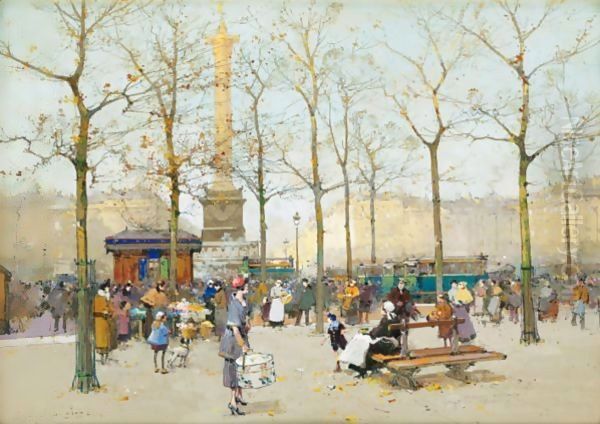
Galien-Laloue made his official artistic debut in 1876. His first exhibited work, titled Le quai aux fleurs par la pluie (The Flower Market Quay in the Rain), was shown at the Museum in Reims. This marked the beginning of a long career dedicated to capturing the multifaceted beauty of France. While he is most renowned for his Parisian scenes, his artistic interests were not solely confined to the capital.
His oeuvre includes numerous depictions of the Normandy countryside and landscapes along the Seine River. These works demonstrate his appreciation for natural beauty alongside the urban environment. However, it was his portrayal of Paris – its grand boulevards, iconic monuments, bustling squares, and the daily life unfolding within them – that truly defined his artistic identity. He captured the city in various seasons and weather conditions, often favoring autumnal and winter scenes, which allowed him to explore specific atmospheric effects and palettes.
Artistic Techniques and Stylistic Traits
Galien-Laloue primarily worked in watercolor and gouache, although he also produced oil paintings. His preference for water-based media, particularly gouache, was noted for its practicality; these mediums allowed for relatively quick execution and were economical, important considerations for a working artist. His technique was characterized by meticulous attention to detail, especially in rendering architectural elements. Buildings, lampposts, kiosks, and carriages were depicted with a precision that sometimes bordered on the photographic.
Despite this realism, his works are far from mere topographical records. Galien-Laloue infused his scenes with a distinct atmosphere, often employing a palette rich in subtle, cool tones to convey the mood of a particular time of day or season. He masterfully captured the play of light and shadow on wet pavements, the hazy glow of gaslights, or the crisp air of a snowy day. His compositions skillfully balance detailed foreground elements with a sense of depth and perspective, drawing the viewer into the bustling yet often romanticized world of Belle Époque Paris. His style, therefore, represents a unique blend of precise draughtsmanship and atmospheric sensitivity.
The Enigma of Pseudonyms
Adding a layer of intrigue to Galien-Laloue's biography is his use of multiple pseudonyms throughout his career. He is known to have signed works under names such as J. Lievin, E. Galyan, and L. Dupuy. The exact reasons behind this practice remain somewhat speculative. Some sources suggest it may have been driven by exclusive contracts with certain dealers or galleries, allowing him to sell work outside these agreements under different names.
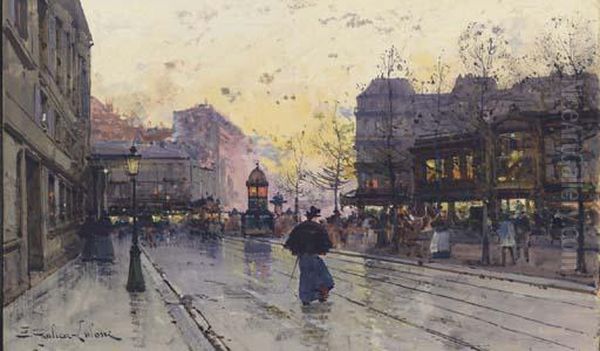
Others propose it might have stemmed from a desire to differentiate stylistic variations or simply from his inherently private nature, perhaps as a way to deflect attention. Whatever the motivation, the use of these aliases has occasionally complicated the attribution of his works and contributed to the somewhat enigmatic perception of the artist himself. It reflects a deliberate choice to control, or perhaps obscure, aspects of his professional identity.
A Reclusive Personality and Working Method
Consistent with his use of pseudonyms, Galien-Laloue was known for his introverted and solitary personality. Unlike many of his contemporaries who actively participated in the Parisian café culture and artistic circles, Galien-Laloue led a relatively simple and secluded life. He was not known for extensive travel and preferred the familiar surroundings of Paris and its nearby regions.
This reclusive nature extended to his working method. While his paintings demonstrate a profound familiarity with Parisian locations, evidence suggests he rarely worked en plein air (outdoors). Instead, he likely relied on sketches, photographs, postcards, and his own sharp memory to compose his detailed scenes within the confines of his studio. This approach allowed him the control and time needed to achieve the high level of finish characteristic of his work. His focus remained steadfastly on his craft, detached from the social dynamics of the art world.
Wartime Experiences and Later Life
The outbreak of World War I marked a significant, albeit temporary, shift in Galien-Laloue's subject matter. Having served in the military previously (possibly during the Franco-Prussian War of 1870, though sources vary on specifics), he was reportedly exempt from active combat duty during the Great War. However, the conflict deeply impacted him, leading him to produce numerous works depicting military scenes and the wartime atmosphere in France.
He continued to explore these themes even after the war concluded. His artistic production eventually ceased around 1940 when he suffered an injury to his arm, making painting difficult. Galien-Laloue spent his final years living quietly, reportedly in Chérence, a small commune northwest of Paris. He passed away in 1941. Some accounts note that the precise circumstances surrounding his death remain somewhat unclear, adding a final note of mystery to the life of this reserved artist.
Key Representative Works
While Galien-Laloue was a prolific artist, several works stand out as representative of his style and subject matter:
Le quai aux fleurs par la pluie (1876): His debut piece, showcasing his early interest in Parisian scenes and atmospheric effects like rain.
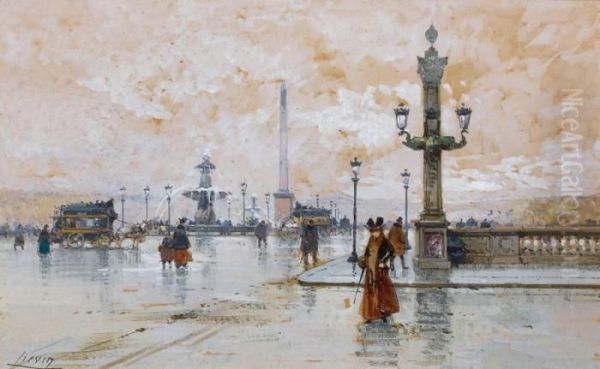
Place de la Bastille (c. 1900): A depiction of one of Paris's most famous historical squares, demonstrating his skill in capturing iconic landmarks within a lively urban context.
Paris Street Scene (c. 1914): Exemplifies his classic Belle Époque scenes, likely featuring horse-drawn carriages, early automobiles or trams, and pedestrians navigating the bustling boulevards. These works often capture the energy and transition of the era.
Place de la Concorde: Paintings of this grand square allowed him to explore expansive perspectives and depict the elegance of central Paris, often under varying light conditions.
Coin de la Place de la République (Effet de Neige): A work noted for being executed in pastel and pencil, highlighting his versatility in media and his fondness for snow scenes, which offered unique opportunities for capturing light and muted color palettes.
Notre Dame: Depictions of the famous cathedral showcase his architectural precision and ability to convey the grandeur of Paris's historic monuments.
Les Grandes Boulevards: Often rendered in watercolor and gouache, these paintings capture the quintessential Parisian experience – the wide avenues lined with trees, kiosks, shops, and filled with the flow of urban life.
These titles represent the core themes and locations that Galien-Laloue returned to throughout his career, solidifying his reputation as the preeminent painter of Parisian street life of his time.
Relationships with Contemporaries and Artistic Context
Information regarding Eugène Galien-Laloue's direct interactions with his contemporaries is limited, largely due to his reclusive nature. However, his career unfolded within the rich artistic milieu of late 19th and early 20th century Paris, placing him alongside many famous names. He studied under Charles Laloue (1), who was a member of the prestigious Société des Artistes Français. This connection provided him with a formal link to the established art world.
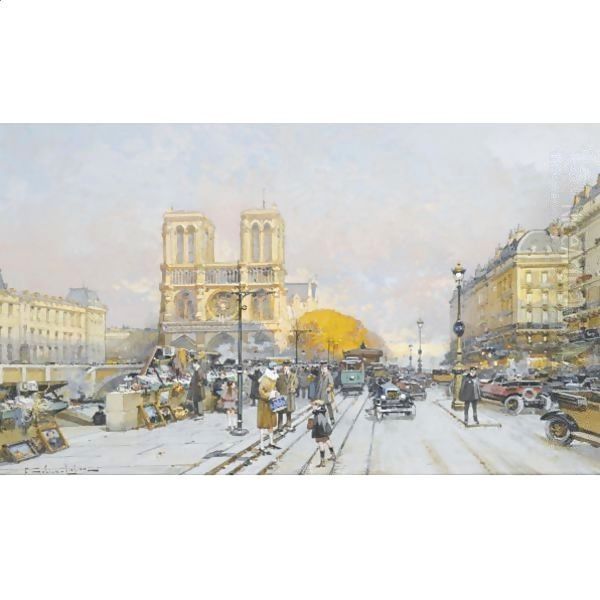
Galien-Laloue regularly exhibited his work at the Paris Salon, the official exhibition venue organized by the Académie des Beaux-Arts and later the Société des Artistes Français. Participating in the Salon meant his work was displayed in the same context as many leading artists of the day, even if personal friendships are not documented. During his active years, the Salon featured works by Academic masters like Jean-Léon Gérôme (2) and William-Adolphe Bouguereau (3), as well as the Impressionists who initially challenged the Salon system, such as Claude Monet (4), Pierre-Auguste Renoir (5), Edgar Degas (6), and Camille Pissarro (7). Post-Impressionists like Henri de Toulouse-Lautrec (8), also known for depicting Parisian life, were his contemporaries.
While the source material explicitly states there is no known record of direct collaboration or close association between Galien-Laloue and the major Impressionist figures, his work shares thematic interests with other painters focused on modern Parisian life, such as Jean Béraud (11) and Gustave Caillebotte (12), the latter also known for his precise urban perspectives. Although direct interaction was minimal, Galien-Laloue's work did exert influence on later generations of Parisian street scene painters, most notably Edouard Leon Cortès (9) and Antoine Blanchard (10), who continued the tradition he so masterfully established. His relationship with the art world seems to have been primarily through formal exhibitions and the legacy of his distinctive style.
Legacy and Historical Evaluation
Eugène Galien-Laloue's artistic achievement lies in his unique ability to capture the specific atmosphere and visual details of Paris during a transformative period. He is often lauded as a "master of the Parisian street scene" and sometimes affectionately termed the "grandfather" of this genre. His paintings are highly valued not only for their aesthetic qualities – the delicate brushwork, harmonious color palettes, and evocative light – but also for their historical significance. They offer a detailed visual record of the city's architecture, transportation (from horse-drawn omnibuses to early motor cars and trams), fashion, and daily rhythms during the Belle Époque and the early 20th century.
While perhaps not achieving the revolutionary fame of the leading Impressionists during his lifetime, Galien-Laloue's reputation grew steadily, particularly later in his career and posthumously. His works became highly sought after by collectors who appreciated his technical skill and the nostalgic charm of his subjects. Today, his paintings are held in museum collections, including the Musée du Louvre (though specific works might be in departmental collections rather than the main display), the Musée d'Orbigny-Bernon in La Rochelle, and the Musée des Beaux-Arts in Mulhouse, among others.
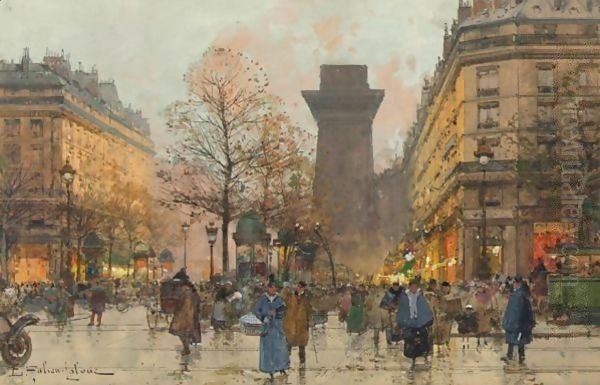
His legacy is that of a dedicated and meticulous artist who documented a beloved city with both precision and sensitivity. He captured the ephemeral moments of daily life against the backdrop of enduring stone facades, preserving the spirit of a bygone Paris for future generations. His work continues to enchant viewers with its detailed beauty and serves as an important reference for understanding the visual culture of Paris at the turn of the century.
Conclusion
Eugène Galien-Laloue remains a cherished figure in French art, a painter whose life's work was devoted to capturing the soul of Paris. Through his distinctive style, characterized by detailed realism blended with atmospheric sensitivity, he created an enduring portrait of the city during the Belle Époque. Working primarily in watercolor and gouache, often from the seclusion of his studio, he meticulously documented the boulevards, monuments, and daily life of Paris, leaving behind a legacy that is both artistically compelling and historically invaluable. Despite his reclusive nature and the use of pseudonyms, his unique vision and technical mastery have secured his place as one of the most important painters of Parisian cityscapes, whose works continue to be admired and collected worldwide.